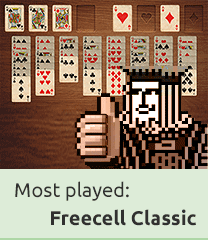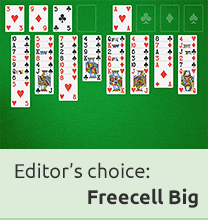All You Need to Know About Freecell
Freecell, along with hundreds of other card games, falls into the solitaire category. The other three most famous and widely played games in this category are Klondike, Spider, and Pyramid Solitaire.
In solitaire games, the objective is to arrange or combine cards in a structured manner to remove them, and they are always played by one person. Freecell Solitaire is played with 52 cards, all face up at the start, allowing the player to develop a strategic approach to solving the game with a minimal number of moves. The game stands out from other solitaire games as it features four empty spaces, known as free cells, which can be used to store cards temporarily.
The predecessors of modern Freecell
In 1945, prior to the introduction of personal computers, the first written record of a game that resembles Freecell was published. The Swedish European bridge champion Einar wrote about the game Napoleon in St. Helena in his book "Världens bästa patienser och patiensspel" (The Best Patience Games in the World). This game has only minor differences from the current version of Freecell. For instance, the last four cards dealt do not go onto the tableau but into the four free cells, and only kings can be placed in empty columns. These factors make the game considerably more challenging.
Another solitaire game that resembles modern Freecell is Eight Off. This game features eight empty cells, four more than Freecell, and the main difference is that the cards on the tableau must be arranged by color instead of alternating. Additionally, empty columns can only hold kings. The game was initially described in the book "Complete Book of Solitaire and Patience Games" by Albert H. Morehead in 1949.
Following that period, not much was written about these games and no new variations were discovered until the renowned American science and mathematics writer Martin Gardner authored a piece in his column "Mathematical Games" in "Scientific American" in 1968. Gardner described a version of Eight Off with only four empty cells, instead of eight. In this variant, all cards, not just kings, can be placed in empty columns. Gardner learned this variant from his fellow mathematician C.L. Baker, who had learned it from his father. The game was dubbed Baker's Game.
The computer age
 After reading Martin Gardner's article, Paul Alfille, a medical student at the University of Illinois, experimented with Baker's Game using actual cards. He soon realized that numerous deals were unsolvable, but after trying different arrangements, he found that sorting the cards on the tableau in descending order and alternating colors made almost all deals winnable. He dubbed this version "Free Cell." Subsequently, Alfille, who was skilled in programming, wrote his first Free Cell game in the TUTOR programming language on the Plato Computer System at the University of Illinois in the United States in 1978, as he grew tired of shuffling cards manually. The program was 6 kilobytes in size and comprised a 960-word code.
After reading Martin Gardner's article, Paul Alfille, a medical student at the University of Illinois, experimented with Baker's Game using actual cards. He soon realized that numerous deals were unsolvable, but after trying different arrangements, he found that sorting the cards on the tableau in descending order and alternating colors made almost all deals winnable. He dubbed this version "Free Cell." Subsequently, Alfille, who was skilled in programming, wrote his first Free Cell game in the TUTOR programming language on the Plato Computer System at the University of Illinois in the United States in 1978, as he grew tired of shuffling cards manually. The program was 6 kilobytes in size and comprised a 960-word code.
The big breakthrough
One of the most noteworthy events in Freecell's history occurred when Microsoft programmer Jim Horne stumbled upon the game on Plato several years later and embarked on creating his own version for Microsoft's DOS system in 1989. His initial version was entirely text-based and the game had 65,535 game numbers, but they were generated using a different algorithm than the current standard game numbers.
 The second version was a graphical one that Microsoft included in the Microsoft Entertainment Pack 2, an expansion for Windows 3.0, in 1991. This was also the first time that the standard Freecell game numbers were introduced. The first version had 32,000 numbers, with only one being unsolvable. The game quickly gained popularity, and during the development of Windows NT 3.1 in 1993, Microsoft's executives decided to include the game as a standard part of their Windows operating systems. Nonetheless, the game remained relatively unknown until the introduction of Windows 95 in 1995, which sparked the Windows craze. Suddenly, everyone had a personal computer at home or in the office, providing them access to solitaire games.
The second version was a graphical one that Microsoft included in the Microsoft Entertainment Pack 2, an expansion for Windows 3.0, in 1991. This was also the first time that the standard Freecell game numbers were introduced. The first version had 32,000 numbers, with only one being unsolvable. The game quickly gained popularity, and during the development of Windows NT 3.1 in 1993, Microsoft's executives decided to include the game as a standard part of their Windows operating systems. Nonetheless, the game remained relatively unknown until the introduction of Windows 95 in 1995, which sparked the Windows craze. Suddenly, everyone had a personal computer at home or in the office, providing them access to solitaire games.
 Microsoft chose not to include the games package as a standard feature in the 2012 release of Windows 8. However, after receiving significant criticism from users, Freecell was reinstated as a standard game in Windows 10 in 2015 and has remained a permanent fixture since. Moreover, the game has also made its way onto the internet and app stores, where the games are typically free to play. This website also offers a diverse range of Freecell online games and entertaining variations, including one with a timer and a perfect replica of the Microsoft version.
Microsoft chose not to include the games package as a standard feature in the 2012 release of Windows 8. However, after receiving significant criticism from users, Freecell was reinstated as a standard game in Windows 10 in 2015 and has remained a permanent fixture since. Moreover, the game has also made its way onto the internet and app stores, where the games are typically free to play. This website also offers a diverse range of Freecell online games and entertaining variations, including one with a timer and a perfect replica of the Microsoft version.



